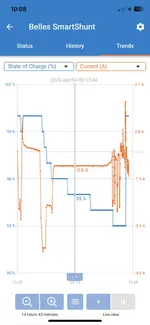I have a basic one AGM battery + one solar + one Victron SmartShunt setup. After a night on EHU and a long motorway run yesterday I’ll accept the battery was at 100% SOC.
Off grid last night tV, charging phones and then some heating this morning the shunt reported 93% SOC, no surprise. You can see the (blue) SOC stepping down in the image
What I don’t understand Is that as soon as the solar was active and the battery current went (minimally) positive reported SOC stepped instantly to 100% … you can just see the blue SOC trace level out on the top right.
Any thoughts appreciated. Faulty shunt?

Off grid last night tV, charging phones and then some heating this morning the shunt reported 93% SOC, no surprise. You can see the (blue) SOC stepping down in the image
What I don’t understand Is that as soon as the solar was active and the battery current went (minimally) positive reported SOC stepped instantly to 100% … you can just see the blue SOC trace level out on the top right.
Any thoughts appreciated. Faulty shunt?



